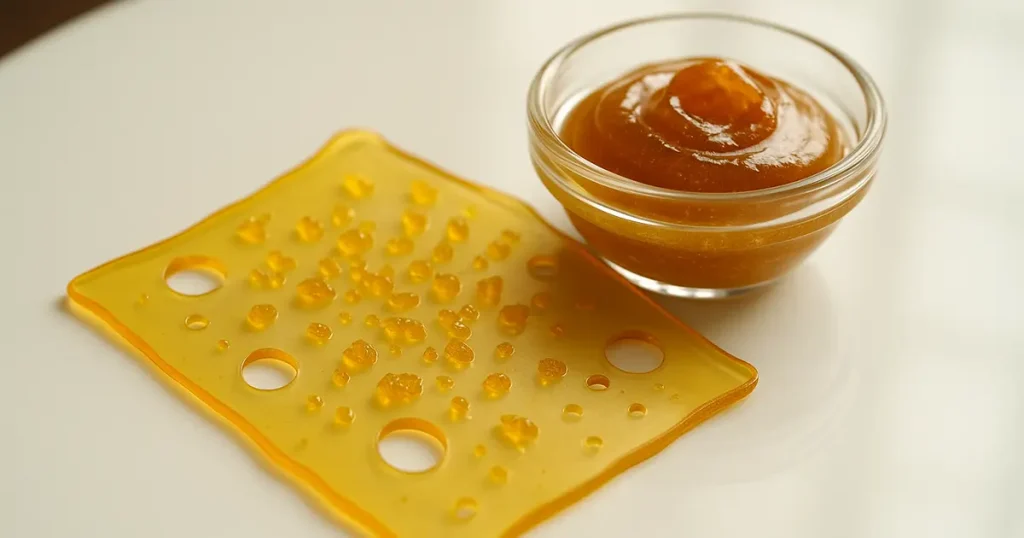CREDIT CARD GATEWAY: Our credit card processor is back up and running!
Check Here for Weekly Promotions! – How can we improve? Any suggestions please email reefsideorder@gmail.com Dismiss

Shatter vs Wax: What’s The Difference And Which Is Better?
You’ve seen the terms shatter and wax all over cannabis menus.
They’re both popular cannabis concentrates.
But they look and handle very differently.
This guide breaks down shatter vs wax in plain language.
You’ll learn what each one is, how they’re made, how they feel to use, and how to pick what fits you best.
We’ll also touch on safety and Canadian rules, so you can shop and use with confidence.
Shatter Vs Wax At A Glance
- Texture: Shatter is hard and glassy. Wax is soft and malleable.
- Handling: Wax is easier to scoop and dose. Shatter can snap and crumble.
- Look: Shatter is usually translucent. Wax looks opaque (creamy or crumbly).
- Potency Labels: Both are high-THC extracts; labels in Canada show Total THC for the package.
- Flavour & Aroma: Wax often keeps more of the strain’s aroma (terpenes).
- Storage: Cool, dark, airtight storage helps both; soft textures tend to age faster if exposed to heat, light, or air.
- Best For: Shatter for tidy dabs and long-term storage. Wax for easy scooping and bold flavour.
The basic texture and handling differences above are widely noted in consumer guides and glossaries. For example, describes shatter as a solid, translucent extract that can be harder to scoop than softer “shatter wax” styles, while wax/budder is softer and easier to pick up.
What Is Shatter?
Shatter is a cannabis extract with a brittle, glass-like texture.
When you snap a piece, it can “shatter,” which is how it got its name.
It’s usually clear to amber and breaks into sharp pieces.
In simple terms, shatter is made by extracting cannabinoids and terpenes from cannabis with a solvent (often butane in licensed labs), then purging that solvent and allowing the oil to cool and set without agitation. That “leave it alone” step helps keep it translucent and glassy.
People often dab shatter using a dab rig or electronic device. Dabbing means heating a surface (a nail or banger), applying a small amount of concentrate, and inhaling the vapour. If you’re new, the method can feel technical, but it’s common with shatter.
What Is Wax?
Wax (also called budder, badder, crumble, or honeycomb) is a softer, opaque concentrate.
It can feel creamy like frosting (budder/badder) or dry and crumbly (crumble).
Wax and shatter often start from similar extracts. The key difference comes from post-processing. When the extract is agitated or “whipped” while purging, it creates tiny crystals and traps micro-bubbles. That changes how light passes through the extract, turning it opaque and giving it a soft, spreadable consistency.
Like shatter, wax is usually dabbed. Many people find wax easier to pick up and dose because it clings to the dab tool instead of snapping apart.

How Are They Made? (Simple Breakdown)
Modern legal concentrates are produced in licensed facilities.
A common path uses a solvent, like butane or propane, to dissolve cannabinoids and terpenes. The solution is then filtered and purged to remove residual solvent under controlled temperature and vacuum. The result is a thick oil that can be set as shatter or whipped into wax during purging.
The “shatter vs wax” split happens mostly during post-processing:
- Shatter: Minimal agitation while purging → flat, glassy sheets.
- Wax/Budder/Crumble: Agitation/whipping or specific temperature-time schedules → soft, opaque textures.
Guides from licensed retailers and educators consistently frame texture as a product of agitation and purge conditions.
Canada note: Legal processors must meet quality and contamination rules for cannabis extracts, including limits aligned with pharmacopeial tolerance ranges for chemical and microbial contaminants. This is part of the federal Cannabis Regulations framework.
Potency, Flavour, And Effects
Both shatter and wax are high-THC concentrates.
On labels, you’ll usually see Total THC for the product. In Canada, legal labels follow federal rules so you can compare products more easily.
You’ll often see shatter listed around 70–90% THC, with wax in a similar range, depending on the strain and process. Keep in mind these are typical ranges from producers and dispensaries, not fixed rules. Always use the actual package label to understand what you’re buying.
Why do some people say wax tastes stronger?
Wax is often processed to preserve more terpenes (the plant’s aroma compounds). More terpenes can mean bigger flavour and a fuller strain character when you dab. That “zesty” hit is one reason many flavour-focused consumers pick wax.
Ease Of Use And Dosing
If you want simple handling, wax tends to be friendlier.
It sticks to the tool, so it’s easier to scoop a consistent amount.
Shatter can be harder to control because it cracks unpredictably.
You might end up with pieces that are larger or smaller than you planned.
If you’re still getting a feel for your dose, wax gives you a bit more control.
Storage And Shelf Life
Concentrates don’t last forever. Heat, light, oxygen, and time all matter.
To protect flavour and potency, keep your shatter or wax cool, dark, and airtight. Short-term, a silicone or glass container at room temperature may be fine; for longer storage, use parchment inside a sealed glass jar in a cool place. Minimize opening the jar to reduce air exposure.
Softer textures present more surface area to air and can lose aroma faster if stored poorly. That’s why consistent, airtight storage helps wax keep its character. Industry guides and retail education resources emphasize tight seals and temperature control to slow oxidation and terpene loss.
Safety Notes: Residual Solvents And Temperature
Residual solvents: Legal Canadian concentrates are tested to ensure solvents are within recognized tolerance limits based on pharmacopeial publications. Look for legal products with lab information and pay attention to labels; the federal framework requires controls for contaminants and clear labelling so you know what you’re getting.
High heat cautions: Very high dabbing temperatures can convert some terpenes into unwanted by-products (like methacrolein and benzene) in experimental setups. While actual consumer temperatures vary, the take-home is simple: avoid overheating your nail or device. Let a torch-heated nail cool before you dab, or use a temperature-controlled rig. This helps protect flavour and reduces the chance of forming harsh by-products.
If you’re looking for broader harm-reduction tips (like delaying use, avoiding deep pulls, or choosing lower-THC products), Canada’s Lower-Risk Cannabis Use Guidelines are a good, evidence-based starting point.

Legality In Canada: What To Know Before You Buy
In Canada, shatter and wax are sold as cannabis extracts.
Key points:
- THC cap for extracts: Legal extracts (including dabs) must not exceed 1,000 mg THC per immediate container. Check the “Total THC” on the label for your product.
- Label basics: Canadian labels provide standard info like THC/CBD amounts and warnings, so you can compare products and dose more carefully.
- Edibles are different: Edibles are capped at 10 mg THC per package. If you prefer a gentler, non-inhaled route, edibles are made for small, measured dosing.
- Don’t DIY with solvents: At home, it’s illegal and dangerous to make solvent-based concentrates using explosive or highly flammable organic solvents like butane or propane. Leave extraction to licensed facilities.
How Dabbing Fits In (And How To Start Gently)
Dabbing is popular because it’s fast and potent.
If you’re new, go very small and see how you feel before taking another dab. A grain-of-rice-sized amount is a common starting point for people learning to gauge their response. Using a temperature-controlled device can help you avoid harsh hits and preserve flavour. For a simple walkthrough of tools and steps, consumer guides are helpful.
Shatter Vs Wax: Which Is Better For You?
There isn’t one right answer.
It depends on how you like to dab, what you value, and your experience level.
Choose shatter if you want:
- Clean, glassy sheets that break into neat, small pieces once you get the hang of it.
- A tidy storage profile.
- Consistent, firm texture that travels well when stored properly.
Choose wax if you want:
- Easy scooping and simple portioning with a dab tool.
- Bold aroma and flavour from preserved terpenes.
- A texture that works nicely with cold starts and low-temp dabs.
If you care most about flavour, wax and budder often deliver a more expressive taste. If you care about clean handling and cabinet-friendly storage, shatter makes sense. Use legal labels to compare Total THC and match your comfort level.
How To Choose Quality Shatter Or Wax
When you’re comparing shatter vs wax, look beyond the name:
- Read the label: Check Total THC, Total CBD, lot number, and warnings. That’s how you know it’s legal and traceable in Canada.
- Match format to your device: If you use a traditional rig, both forms work. If you use a pen or e-rig with small chambers, wax may be easier to load. Consumer guides on dabbing tools can help you decide.
- Think about storage: If you open the jar often, plan for a tight seal and a cool, dark place. That protects terpenes and slows oxidation.
- Respect heat: Let hot nails cool or use temp-controlled devices to reduce harsh by-products and keep flavour.
If You Prefer Edibles Or Want A Gentler Start
Not everyone wants to dab.
If you’d rather eat your cannabis, edibles are capped at 10 mg THC per package in Canada. That cap is there to support careful dosing and reduce accidental overconsumption. Start low, go slow, and wait to feel the full effects.
If you’re exploring edibles, Reefside has guides and product education to help you choose thoughtfully and use responsibly.
The Bottom Line
- Shatter and wax are both high-THC cannabis extracts.
- The key difference is texture, shaped by post-processing.
- Shatter is firm and glassy. Wax is soft and easy to scoop.
- Potency is high for both, so go small, especially if you’re new.
- Store in a cool, dark, airtight space to protect flavour and effect.
- In Canada, buy legal products, check labels, and know the THC limits for extracts and edibles.
If you value flavour and easy handling, wax may feel better day-to-day.
If you prefer tidy sheets and longer storage, shatter might suit you.
Either way, choose legal, read labels, mind your temperature, and take your time.
When you’re ready to try edibles or want more cannabis education, visit Reefside.cc for clear, down-to-earth resources.
REFERENCES:
Vertava Health. (2022). What is Shatter? Available at: https://vertavahealth.com/marijuana/shatter/
Takoma Wellness Center. (2022, October 19). Cannabis Concentrates: What is THC Wax?. Available at: https://takomawellness.com/marijuana-wax-what-is-it-and-how-to-use-it/
Dr. Leslie Lars Iversen, CBE FRS MAE
Categories
- Accessories (13)
- Best Sellers (51)
- Brands (189)
- Alivia (6)
- Faded (2)
- Syringe Oil (1)
- Vape (1)
- Firecracker (12)
- FRESH (13)
- Pre-Rolls (12)
- GAIA Wellness (31)
- Grandpa's (1)
- Green Supreme (6)
- Happy High (4)
- High Dose (8)
- ILU (1)
- Island Therapeutics (6)
- Jelly Bites (6)
- Mastermind (9)
- Capsules (5)
- Chocolate Bar (4)
- P.S. I'm Baked (5)
- Peazys (1)
- Proper Extracts (9)
- Reefer Kings (2)
- Reefside (4)
- Social Cannabis (1)
- SS7 (7)
- Pre-Rolls (7)
- Twisted Extracts (61)
- Buy in Bulk (19)
- Capsules (14)
- Concentrates (10)
- Edibles (77)
- Bundles (2)
- Caramels & Toffee (13)
- Chocolates (4)
- Gummy Candy (61)
- Jelly Bombs (18)
- Organic (1)
- Salted Caramelts (6)
- Sour Twisted Singles (17)
- Gift Card (1)
- Highly Potent (37)
- New Arrivals (80)
- Pre-Rolls (34)
- Sativa Selects (29)
- Shop by Strain Type (120)
- CBD (37)
- Hybrid (2)
- Indica (32)
- Indica 1:1 (7)
- Sativa (38)
- Sativa 1:1 (10)
- Sleep Easy (22)
- Staff Picks (33)
- Tinctures & Oil Drops (27)
- Topicals (14)
- Bath, Beauty and Skin (7)
- Pain Relief (9)
- Uncategorized (11)
- Vapes (9)
- Vape Tops (8)
